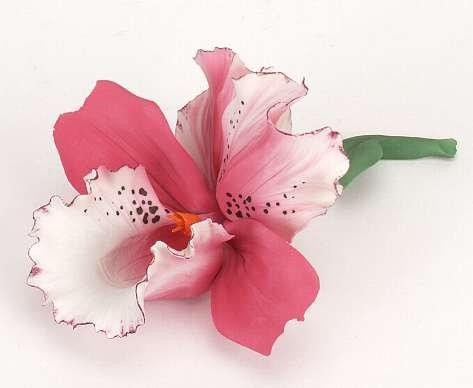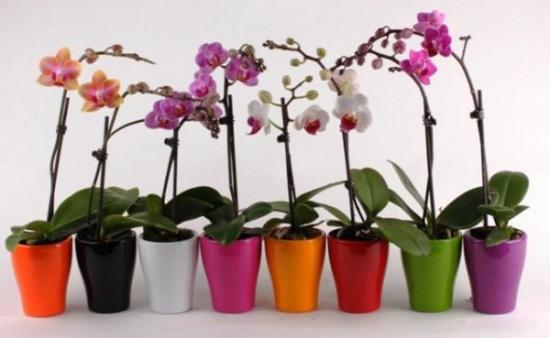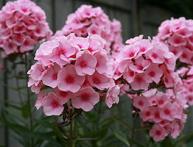Orchid: proper plant transplantation and propagation

In the home of every gardener you can find an unusual and amazing plant - an orchid. This is a perennial herbaceous plant that has about 100 thousand species.
Not every one of them will be able to take root in indoor conditions.. The plant is unpretentious to growing conditions, however, when replanting, some features should be taken into account.
Content:
Description of the orchid

Orchid belongs to the Orchidaceae family. All orchids are divided into 2 groups:
Ground. They are grown in pots and rooted in the ground. The soil mixture may consist of humus, sand, rotted leaves, peat, etc.
Epiphytic orchids are more adapted to home conditions. The most numerous group are aerial orchids, the so-called epiphytic ones.
Under normal conditions, they are closely related to other plants, from which the bark is constantly enriched with essential nutrients. In order to renew the supply of necessary nutrients, it is important to replant the orchid in a timely manner.
This flower has simple and entire leaves, green in color, attached to a thick, straight, bulbous stem at the base.
The flowers of the plant are solitary and collected in racemose and spike-shaped inflorescences. The corolla of an orchid consists of 6 petals - three lower and three upper.They are located in two circles. The fruit of the plant resembles a box in which dust-like seeds are collected.
How and when to replant an orchid
Once purchased, an orchid does not need to be replanted, but there are some reasons for which replanting is indispensable.
To make the orchid look beautiful, in a flower shop they spray her with stimulants that strengthen her bloom. When purchasing, it is important to pay attention to the root system. If the roots of the plant seem wrinkled and pale, then replanting must be done immediately.

The main reasons for replanting a plant:
- If more than a year has passed since the purchase of the plant, the soil begins to decompose and rot. This will be indicated by soil moisture, which can last for more than a week.
- Replanting should be done if the root system is damaged. The following signs may indicate this: spots and yellowness are observed on the leaves, the roots begin to turn black.
- If the orchid does not bloom for more than 3 months, the roots do not fit into the container and the leaves exceed the volume of the pot, then the plant also needs to be replanted.
The optimal time to replant a plant is after flowering. Since an orchid can bloom for several months in a row, this event will not affect further flowering in any way, and in some cases can even prolong it.
It is better to replant when the growing season of the plant begins, in spring or autumn.
The container for transplantation should be plastic or metal. If there is not enough lighting in the room, then the pot should be transparent.
Transfer plants into a new pot is carried out as follows. Initially, the earthen lump should be freed.To do this, carefully squeeze the orchid bush and pull out the plant along with the soil.
If this is difficult to do, then the pot can be divided into 2 parts. Next, remove chips of bark and other particles of the old substrate from the root system. To do this, immerse the lump in warm water. After this, rinse the roots with a shower.
Then you need to carefully examine the roots of the orchid. If there are damaged, rotten, wrinkled roots, they should be removed. Sprinkle the cut areas with crushed charcoal. The roots of the plant must be completely dry.
To do this, place the plant on a paper towel. While the roots are drying, you should prepare a new pot for the orchid. The pot needs to be disinfected: lower the container into a strong solution of potassium permanganate and wait for a while.
Next, place a 2 cm drainage layer on the bottom of the pot. Expanded clay is suitable for this. The substrate for the plant can be purchased at a special store, or you can make it yourself.
It may consist of bark, vermiculite, perlite, coconuts, fern roots, moss, etc. Pour the prepared substrate into the pot and place the orchid in it.
Then gradually pour the soil into the container. If there are hanging stems, then place a stake nearby to tie them up. The stick is attached to the stem using clamps.
How to propagate an orchid correctly

Orchid propagation occurs in one of three ways: cuttings, dividing the bush or planting seeds.
The easiest way to grow an orchid is propagation using stem suckers. To form new varieties, small plants called “babies” can be seen on the side shoots.
They appear in orchids with a high nitrogen content.If suckers appear on side shoots, then the plant needs frequent spraying.
After a few days they will put out roots. They must be carefully separated from the stem, and then treated with charcoal and planted in a separate container.
Another way to propagate a plant is by cuttings. Implemented reproduction as follows: carefully cut off a shoot from the side of the orchid stem. You can also use flower stems that have already bloomed. Next, cut cuttings 10-15 cm in size.
Then place them on the soil surface under the film to create greenhouse conditions. It should be moistened first. For soil, you can use moss or sand. You should know that each cutting must have at least two nodes of axillary buds.
It is quite difficult to propagate an orchid by seeds, so this method is not used.
Video about proper flower propagation:
Interesting information about the vegetable garden











Comments
I really want to plant flowers on the balcony, but the importance of many nuances stops me. I am collecting information from your blog bit by bit. Orchid is one of their favorite flowers. I'll try to breed)